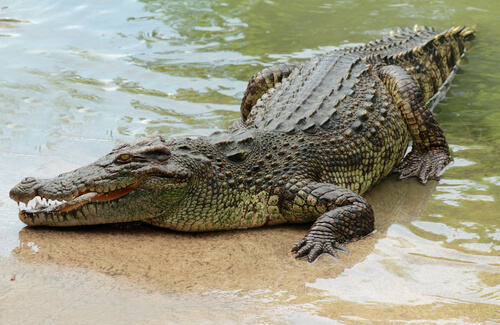the crocodiles
Curiosities about crocodiles
Curiosities about crocodiles
Did you know that crocodiles hibernate in the coldest winter months?
Crocodiles (Crocodylidae) are semi-aquatic reptiles that inhabit the tropical regions of Africa, Asia, America and Australia. They belong to the Crocodilia order, which also includes alligators and gharials. In addition, there are currently 14 different species of crocodiles, so it is possible to find them of many sizes.
The smallest crocodile is the pygmy crocodile. It measures approximately 1.7 meters long and weighs 6 to 7 kilograms. On the other hand, the largest crocodile is the saltwater crocodile, as it can reach 6 meters in length and weigh up to 900 kilos.
On the other hand, crocodiles are carnivorous animals. In their natural habitat they feed on fish, frogs, birds and crustaceans, while in zoos they can also eat small animals such as mice, rats or even lobsters. Also, in the wild, crocodiles use their jaws to crush their prey and swallow it whole, as they do not have the ability to chew or break food into small pieces.
These reptiles live mostly in tropical climates, as they are cold-blooded and their body temperature depends entirely on the ambient temperature. For this reason, in the coldest months of winter they enter a period of hibernation in which they slow down their metabolism and respiration. Also, to create a suitable place, they dig a burrow near the shore of the river or lake.
They are very long-lived
Although the lifespan depends on the species, they are very long-lived animals that can reach 70 years. The oldest crocodile in the world, known as Henry, is currently 120 years old.

They swallow the stones

They have salt glands
Crocodiles have salt glands on their tongues that help them tolerate salt water. Other reptiles, such as alligators, have lost the ability to secrete excess salt through glands, so they prefer fresh water.

They lay many eggs

They don't sweat

Replace your teeth
Crocodiles quickly replace the teeth they lose. In fact, they can regenerate around 8,000 teeth throughout their lives.

They have a great ear

It can weigh up to 800 kilos. Its thick and rough skin has been longed for by the human being to be used in the leather goods business. It is not surprising that the crocodile does not get along with man... This act has put the reptile in danger of extinction, and that is why this act is increasingly penalized by law. In fact, new laws are constantly being created to stop this action.
Crocodile in the river.
They can measure up to 6 meters long, can you imagine seeing one of such characteristics?
His nostrils are meticulously created to suit his aquatic life. These prevent water from entering and reaching their lungs while they are under the fluid. Thanks to them, which allow it to breathe, the crocodile could be underwater for six hours while moving and up to two days at rest.
It is able to regulate its body temperature with its jaws. Opening them allows you to cool or heat it, which is why we have seen many videos of crocodiles with their mouths wide open without attacking anyone. It was in the process of temperature regulation.

Behavior
The crocodile moves almost by crawling on the ground with its four legs, two front and two rear. The front ones have five fingers and the back ones only four. This serves, along with its long tail, to maintain balance, something that would not be so easy due to its weight and measurements.
It usually spends much of its immobile life in freshwater rivers, or in saltwater beach mangroves. They are adaptable and move from one habitat to another at will or according to their needs.
.jpg)
Comentarios
Publicar un comentario